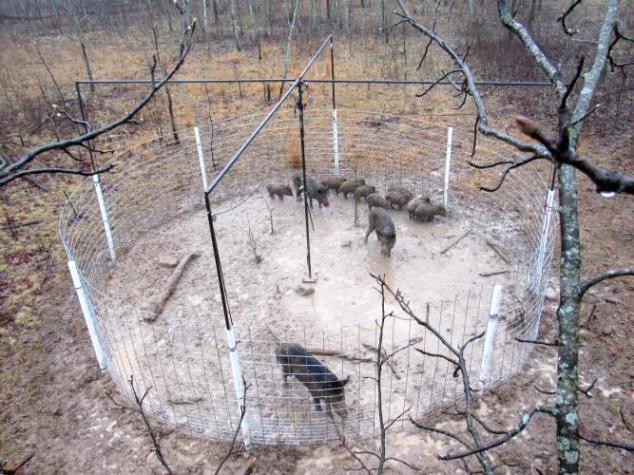SALEM, Mo. – If anything is worse than a pasture rooted up by feral hogs, it’s a pasture that dries and hardens after hogs leave damaged areas the size of tractor tires.
Freddie Leroux’s damaged pastures need to be repaired and reseeded. He waits for soaking rains to soften the ground so he can smooth out ruts.
Leroux works with University of Missouri Extension feral hog outreach educator Kevin Crider and others to eradicate feral hogs through the Missouri Feral Hog Elimination Partnership.
The partnership is funded by the 2018 U.S. Farm Bill and managed by the Missouri Department of Conservation. More than 15 federal and state entities, including MU Extension, the U.S. Forest Service and the U.S. Department of Agriculture, work together to eliminate feral hogs on public and private lands in 27 southern Missouri counties.
Leroux acquired the 1,600 acres of pristine rolling hills and forest that adjoin Missouri Department of Conservation property for conservation, recreation and hunting. The area is largely unpopulated, with deep ravines in the drainage system of the Current River.
The land is also premium real estate for feral hog herds called sounders that damage land, trees, water sources and wildlife.
Relatively undisturbed for centuries, no humans live there. Trees provide safe cover and a place for hogs to scratch with their bristly bodies and mark their territory. That’s satisfying for the hogs, but it’s usually deadly for saplings.
The woods are a buffet for feral hogs, with eggs of nesting turkeys and other ground nesting fowl, and vulnerable wildlife like deer and rabbits. Grubs and earthworms, their food of choice, grow in the warm-season grass ecosystem and beneath trees. Acorns are a fall favorite. Ponds, streams and rivers provide drinking water and serve as wallowing holes. It’s pig paradise.
Acres of land used for agriculture and forestry “bloomed and mushroomed” with feral hogs when recreational hog hunting became popular in southern Missouri, says Leroux. Escaped hogs bred until the woods filled with the beady-eyed beasts.
Five feral hogs can quickly turn into 30 because of their prolific breeding habits, says Leroux. They breed early and often. Sows can breed by 6 months of age and give birth to two litters of 6-12 piglets each.
Leroux says he has only seen one feral hog on his land, but cameras on his property tell a different tale. As many as 30 feral hogs roam his land in a sounder at night. They use their snouts to root up pastureland, wildlife plots and fences. Worn paths throughout the woods show where they go on their nocturnal rampages.
Leroux says he is glad to support the Missouri Feral Hog Elimination Partnership and appreciates the expertise of Crider and USDA wildlife specialists. “MU Extension and USDA have this down to a science. It’s a great example of partnership,” he says.
He gives them full access to his land and helps to promote the partnership to other landowners. He also is glad that local Soil and Water Conservation Districts received funding to buy equipment to lend to landowners to repair damaged land. The equipment includes no-till drills, cultipackers and harrows.
Leroux tries to be a good steward of the land so that the next generation of his family can enjoy its natural beauty. He uses practices recommended by MU Extension, USDA Natural Resources Conservation Service, USDA Environmental Quality Incentives Program and Missouri Department of Conservation. He plants native warm-season grasses and wildlife food plots, performs prescribed burns and thins timber.
The success of the Missouri Feral Hog Elimination Partnership depends on landowners like Leroux, Crider says. The group removed 6,289 hogs in 2022, worked with 709 landowners and scouted 3.7 million acres, mostly south of Interstate 44.
With the group’s help, the total number of acres of watershed occupied by feral hogs in Missouri has fallen by nearly 65% since 2016. 2022 marked the second year that numbers declined, with efforts in Iron, Shannon, Wayne and Reynolds counties netting the best results.
To report feral hog damage or receive assistance, call the Missouri Department of Conservation at 573-522-4115 ext. 3296 or visit Feral Hogs in Missouri.
Funding for this project comes from the Feral Swine Control Program through the USDA as part of the 2018 Farm Bill. Missouri Department of Conservation is the lead agency on the project.
Photos
Rooting
Feral hogs uproot land in search of earthworms, grubs and acorns. The Missouri Feral Hog Elimination Partnership, comprising more than 15 state and federal agencies, works to eradicate feral hogs. Photo courtesy of Kevin Crider.
Freddie Leroux and Kevin Crider
Freddie Leroux, left, is a landowner working with MU Extension feral hog outreach educator Kevin Crider, right, in the Missouri Feral Hog Elimination Partnership. More than 15 federal and state agencies and landowners work to eliminate feral hogs in southern Missouri, where hogs have damaged farm and forest land. With the group’s help, feral hog numbers have decreased by nearly 65% in Missouri watersheds since 2016. Photo by Linda Geist.
